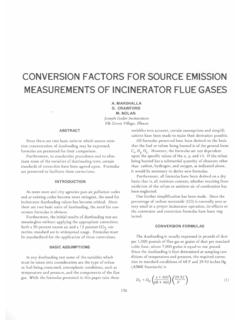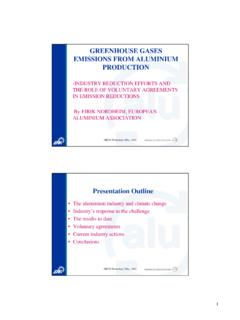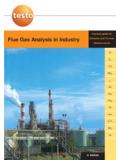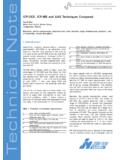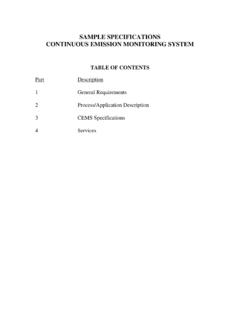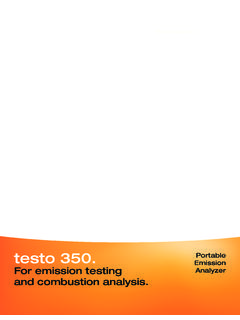Transcription of Air-Free Measurement of Carbon Monoxide Emissions ... - Karg
1 Air-Free Measurement of Carbon Monoxide Emissions from Gas Ranges:Analysis and Suggested Field ProcedureRichard Karg, Karg AssociatesIntroductionGas ranges are probably the most common unvented gas appliances in use in North America. Because they areunvented, they have the potential of significantly contributing to hazardous ambient indoor levels of carbonmonoxide (CO). Fortunately, in most residential situations, they are not operated for long enough intervals toadversely affect occupants. However, there are cases where gas oven/ranges can emit enough CO to cause healthhazards or trigger CO alarms. Examples include 1) user operation of a gas oven/range as a space-heatingappliance1; 2) user alteration of the oven, such as lining the oven bottom with aluminum foil, inadvertentlycovering the secondary air ports; and 3) malfunctioning equipment, including excessive gas pressure, closed airshutters, damaged orifices, and warped flame spreaders.
2 As dwellings become tighter, the possible hazard of CO Emissions from gas ranges increases. Lower airleakage rates can lead to higher ambient indoor CO levels resulting from a given source. This is of special concernfor those tightening dwellings for the sake of saving energy: A given CO emission from a gas oven before housetightening might become dangerous after tightening. For example, if a particular mobile home is tightened air change per hour (ACH) to ACH, the ambient indoor Carbon Monoxide levels resulting from the gas rangeemissions would increase from 32 parts per million (ppm) to 54 It is important to develop a reliable field procedure for measuring Carbon Monoxide Emissions from gasovens/ranges for many reasons, including 1) the use of gas ovens/ranges is widespread, 2) these appliances areoften used as space-heating devices, 3) dwellings are becoming tighter, and 4) the public is becoming increasinglyaware of the hazards of Carbon Monoxide .
3 This field procedure should be in conformance with the AmericanNational Standard (ANSI ) to which manufacturers of gas ranges must comply. This article is an effort tomove toward such a COAs the awareness of CO hazards increases, more technicians are using meters for Measurement of COemissions from combustion appliances. These electronic devices are connected to a plastic hose with a metal probeat the other end. When measuring CO Emissions from a vented appliance, the metal probe is inserted into a drilledhole in the metal flue pipe. A vacuum pump in the Measurement device pulls combustion gases through the metalprobe, into the plastic hose and the CO Measurement cell, and finally expels the gases through an exhaust of CO Emissions from a gas oven is performed with a similar technique.
4 However, rather thaninserting the probe into a drilled hole in a vent pipe, the metal probe is inserted into the oven-vent port that isusually located at the rear of the flat range meters report emission concentrations in units of parts per million (ppm). One hundred ppm is theequivalent of percent; one thousand ppm is the equivalent of percent. One ppm is the similar to one inch insixteen miles, one penny in $10,000, or one red Ping-Pong ball in a swimming pool full of white Ping-Pong are two scales with which to measure CO: one is as-measured and the other is Air-Free . As-measured is the method used by most technicians today. The CO is measured from a sample of combustiongases with no regard for the amount of excess air diluting the CO concentrations. Excess air is the amount of air (specifically oxygen) in the combustion gases in excess of the exact amountneeded for perfect combustion.
5 When combustion is perfect, just the right amounts of fuel and oxygen are suppliedto the combustion process so that all the oxygen is utilized no oxygen remains in the combustion gases. 10/15/98 S:\AMIPRO\DOCS\ Carbon Monoxide \COairfree 1998 R. J. Karg Associates2 The example mobile home is 5400 ft 3, the oven (18,000 Btu) and one range-top burner (9,000 Btu) are operating for two hours, the fuel is naturalgas at 1,000 Btu per cubic foot of gas, the gas flue products are cubic feet per cubic foot of fuel, the source strength of CO is 1000 ppm equation 4 for calculation S. Heckerling, MD, et al. Predictors of Occult Carbon Monoxide Poisoning in Patients with Headache and Dizziness, Annals of InternalMedicine, Vol. 107, No.
6 2, (August, 1997), 174-176. The authors states: Among our patients, many of whom were indigent, 39% used gas stoves forsupplemental heat, which was a significant predictor of the carboxyhemoglobin level. And: These studies, as well as ours, suggest that in patientpopulations with inadequate home heating systems, use of stoves [gas ovens/ranges] for supplemental heat is common, and may be an important source ofCO. Chances are that in many cases, as a result of room overheating, the range burners are turned off before CO concentrations reach dangerous basic problem with the as-measured method is this: As the amount of excess air increases, theas-measured CO value falls for a given source strength of CO. In other words, the amount of excess air in thesample can significantly influence the as-measured value.
7 This can cause a technician to mistakenly think that ahazardous burner is working Measurement of CO takes account of the amount of excess air by incorporating an adjustment to theas-measured ppm value, thus simulating Air-Free (oxygen- free ) conditions in the combustion gases. To do this, areading of oxygen (O2) or Carbon dioxide (CO2) percentage is taken from the combustion gases along with theas-measured CO reading. This can be done with a meter having the capability of measuring CO and O2 or CO2percentage, or it can be done with two different meters, one measuring CO ppm and one measuring O2 or Air-Free CO is determined with a single meter, the meter will have an integral electronic chip that willcalculate the Air-Free level from as-measured CO ppm and O2 two meters are used, the equations below can be used to determine the Air-Free level of CO in a combustiongas natural gas or propane, using as-measured CO ppm and O2 percentage:(1)For propane, using measured CO ppm and CO2 percentage:(2)For natural gas, using measured CO ppm and CO2 percentage:(3)Where.
8 COAFppm = Carbon Monoxide , Air-Free ppmCOppm = As-measured combustion gas Carbon Monoxide ppmO2 = Percentage of oxygen in combustion gas, as a percentageCO2 = Percentage of Carbon dioxide in combustion gas, as a percentageThe Problem with As-Measured ValuesFrom any combustion, the highest percentage of oxygen (O2) possible is percent (that of the earth satmosphere), and the lowest is zero, resulting from stoichiometric (perfect) or oxygen-starved combustion. Whereasthe O2 content of combustion gases from natural gas or propane furnaces or boilers is usually within a range of 4 to10 percent, the percentage of O2 for a natural gas orpropane oven is much higher, normally within a rangeof 14 to 20 percent. This Oven A, the as-measuredCO level is 18 ppm; safe by most higher range of O2(excess air) in the combustion gases leads to loweras-measured readings.
9 The two ovens pictured here demonstrate theinherent problem with as-measured values. Assumeboth ovens have the same Btu/hr burner input. Forstandards. For Oven B, the as-measured CO level is209 ppm; unsafe by most standards. However, eachoven is emitting the same level of Air-Free CO: 400ppm. In other words, the source strength of CO fromeach oven is the same. Most technicians would pass10/15/98 S:\AMIPRO\DOCS\ Carbon Monoxide \COairfree 1998 R. J. Karg AssociatesCOAFppm=14co2 COppmCOAFppm= O2 COppmCOAFppm= COppmOven BAs-Measured CO = 209 ppmOxygen = 10% Air-Free CO = 400 ppmOven AAs-Measured CO = 18 ppmOxygen = 20% Air-Free CO = 400 ppmOven A and fail Oven B, not understanding that each is contributing equally to hazardous levels of ambient indoorCO.
10 It is important to understand that the source strength has a direct effect on the ambient indoor levels of CO. Ifair- free CO is measured, technicians get a much better idea of the effect the CO Emissions will have on indoor airconcentrations. As indicated above, the higher the percentage of O2 (excess air) in the combustion gases, the lower theas-measured CO readings will be. If excess air is zero, as-measured and Air-Free measurements will be equal. Asexcess air increases, as-measured CO readings decrease, but Air-Free readings do not change. The high excess airpercentages for gas ovens and range-top burners increases the importance of taking Air-Free measurements. This isbecause the high excess air can significantly lower as-measured readings, thus falsifying the true CO source is common to find a 17 percent oxygen content in oven combustion gases.








